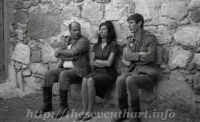Lebenszeichen (1968) (aka Signs Of Life)
Werner Herzog
German
“Dammit! This place is full of roaches. They’re not harmful. They are the most repulsive things on earth. They don’t even bite.”

German master Werner Herzog has made more than 50 feature films and he is as intriguing as ever. His films, though he has requested people not to read too much into them, have made us raise so many questions about the world we live in. His first feature film Signs Of Life(1967) holds as many questions for us as does his recent Oscar nominated documentary Encounters At The End Of The World. Herzog’s natural affinity for documentary filmmaking shows as he presents the film in a cinema vérité style employing low-lying camera angles and without a soundtrack for most part of the film.
Signs of Life, at first glance, seems like an extension of his short film, The Unprecedented Defence of the Fortress Deutschkreuz (1967), which also followed a group of soldiers trying to take down a bunch of non-extant enemies. Here, Herzog presents us a soldier, Stroszek, who has been injured in war and has been relocated to a quieter place in Greece’s countryside for recuperation. He is put in charge of the defense of an isolated fortress housing 50 tons of ammunition along his Greek wife Nora and two other soldiers Becker andMeinhard. He spends the nights guarding the fort against nothing and the day time lazing around.
This radically new environment has variegated effects on the psychology of the three people who are used to bloodshed and constant unrest in the battle fields.Meinhard seems to rip apart every critter that comes his way and conjures up contraptions and techniques to eradicate the lesser creatures. Stroszek is petrified as he desperately looks for signs of life. He tries to invite a passing gypsy into the fort but is stopped by the probable-misanthrope Meinhard. He looks at Meinhard’s “victims” with childlike curiosity and even goes on to mentally animate the wooden owl that the gypsy presents him. And between these two people is the well-read Becker who tries to adapt himself to the milieu and stay flexible unlike the other two.
In the short film, the soldiers mention that it is an obligation for the enemy to attack and a defensive stance is equated to cowardice and desertion. They say that a state of passivity is just an illusion of peace and a delusory cover for barbarism that is to be unleashed. The soldiers in Signs of Life find themselves in a similar state of mind. They are supposed to guard an arsenal that they cannot use. The town that surrounds them is either made of toddlers or old men. The animals in vicinity are passive insects and lazy pets. Even the landscape is pacific yet carries a sense of foreboding with it. The walls of the fortress they defend are decorated with artifacts resembling human body parts (which may have been real human parts, considering what Becker tells us about the ancient Greeks). It seems like almost an insult to the soldiers that they have to defend the fort against dead partisans and a peasant crowd. And Herzog’s B&W cinematography adds to the barrenness of it all.
Why Signs of Life is all the more surprising is that the themes that would haunt the director and his works in the decades to come not only show their roots in this film but establish themselves with as much conviction as their descendants.Herzog translates his cynical view of Mother Nature and the inherent savagery that it conceals with its beauty using the landscape of the environment and of his characters’ mind that manifests itself through the bizarre acts they perform. We regularly see flora and fauna obstructing our view of the characters as if devouring them. There are bugs flying around he household irritating the soldiers.
It seems like Herzog is suggesting that humans and perhaps even the whole of nature is self-destructive to the core and would perish if not controlled by a higher order. Like the “cannibalistic” chicken in Even Dwarves Started Small(1970), Stroszek seems to be celebrating self-mutilation as he tries to hold explosives in his hand while they go off. This rage for self-destruction escalates to the point where he threatens to blow up the whole town with the stack of explosives under his control. This pervasive need to constantly expose oneself to danger may perhaps be the reason he opens fire at random in the first place. Now, once Stroszek is rendered a threat for the greater part of the human community, it is up to higher establishments of the society – Law and Science – to bring him down and save the town. Is Herzog suggesting that slavery is the only way of survival? Are we all subconsciously Darwinian in the way we tend to trivialize the lives of lesser beings? I don’t know, but Herzog sure does know the knack of both entertaining us and making us think.
March 31, 2009 at 2:52 pm
I’m gonna get the original copy of this movie soon. And hoping I can watch it too… Godard is still lying on my shelf.
LikeLike
March 31, 2009 at 2:54 pm
argh… I know how it feels to see stagnant films :)
LikeLike
April 28, 2009 at 9:01 pm
[…] And this is where Pather Panchali gets deeper than meets the eye. Exactly like Herzog would do in Signs of Life (1968), Ray often composes his shot such that there is interaction between man and nature, with the […]
LikeLike
April 4, 2010 at 4:48 pm
[…] guarding the outpost that is far from being under threat is reminiscent of Herzog’s Signs of Life (1968), where, too, the very purpose of existence of the characters was questioned. But unlike […]
LikeLike